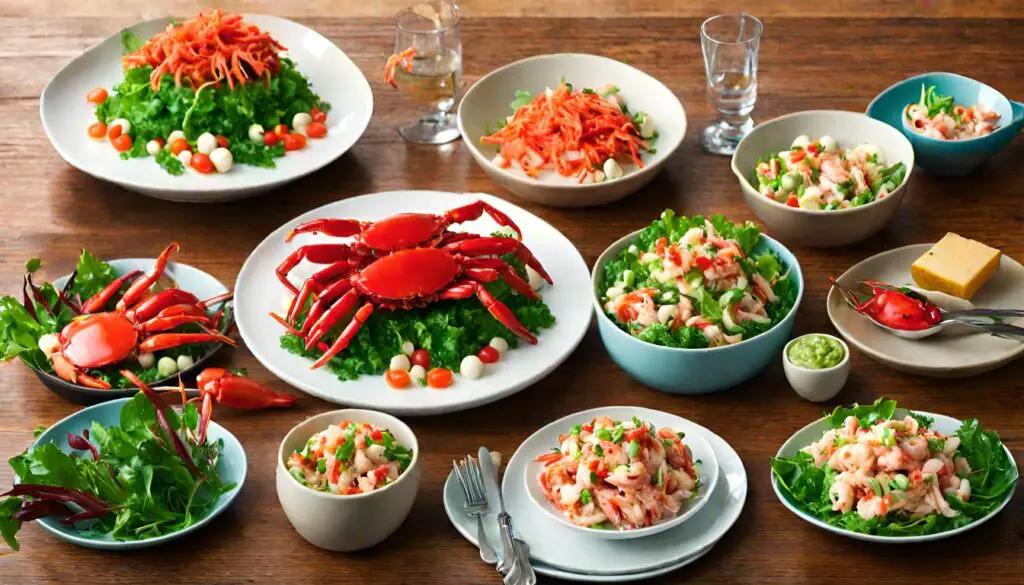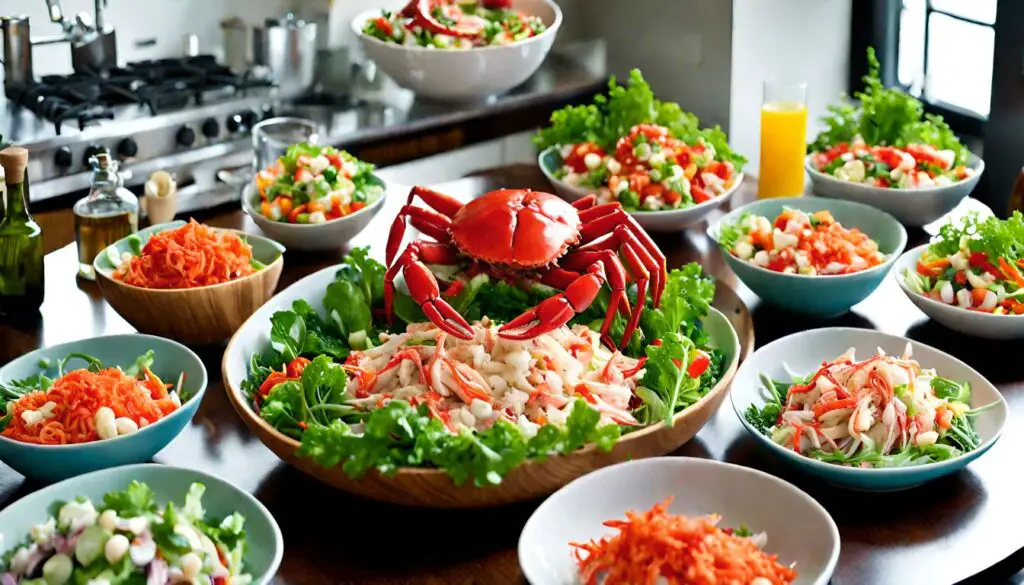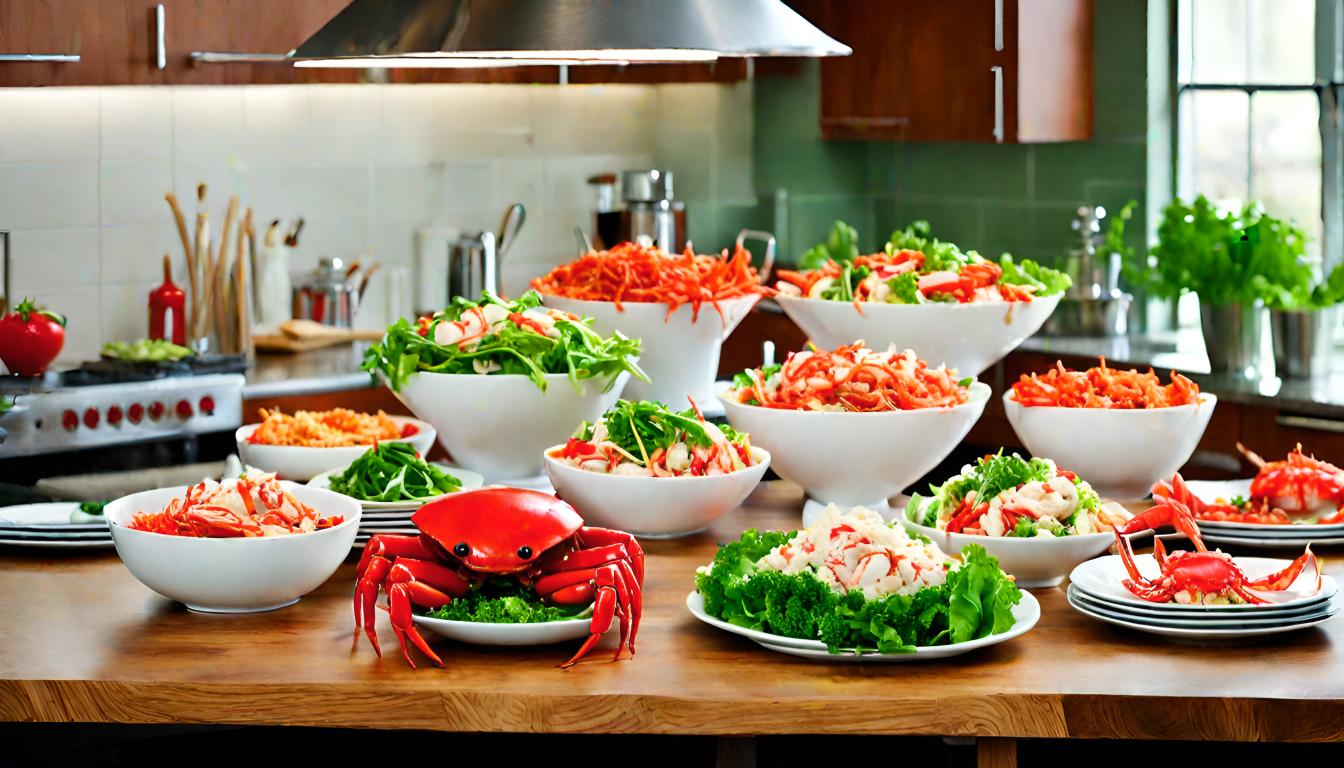Introduction to Imitation Crab Recipes
Imitation crab, a staple in many seafood dishes, offers an accessible and budget-friendly alternative to real crab meat. Its inception dates back several decades, making it a longstanding favorite in various cuisines, particularly in Asian and Western cooking.
What is Imitation Crab?
Imitation crab is a processed seafood product, also known as “crab stick,” “kani,” or “surimi seafood.” It’s crafted from surimi, a fish paste typically made from mild white fish like pollock or hake. The surimi is mixed with other ingredients such as starch, egg whites, sugar, salt, and natural or artificial flavorings that emulate the taste and texture of real crab. The mixture is then cooked and formed into shapes resembling crab meat, often colored with red or orange food coloring to mimic the appearance of cooked shellfish.
The History and Evolution of Imitation Crab
The concept of surimi dates back over several centuries in Japan, where it originally served as a method to preserve fish. Modern-day imitation crab emerged in Japan in the early 1970s as a more cost-effective alternative to crab meat. Since then, it has gained immense popularity worldwide due to its versatility, affordability, and convenience.
Benefits of Using Imitation Crab
Imitation crab offers several advantages:
- Affordability: It’s significantly less expensive than real crab meat, making it a great option for budget-conscious consumers.
- Convenience: Pre-cooked and ready to eat, it saves time in meal preparation.
- Long Shelf Life: It can be stored longer than fresh seafood, reducing food waste.
- Versatility: Imitation crab can be used in a variety of dishes, from salads and sushi rolls to pastas and casseroles.
- Allergen-friendly: For those allergic to shellfish but not to fish, imitation crab provides a safe alternative.
Nutritional Aspects
While imitation crab is lower in protein and omega-3 fatty acids compared to real crab, it’s a low-fat food and a source of several minerals and vitamins. However, it’s worth noting that it often contains additives and preservatives, making it higher in sodium and potentially containing gluten, a concern for those with specific dietary restrictions.

Culinary Uses
Imitation crab’s flavor and texture make it a versatile ingredient in the kitchen. It can be eaten straight from the package, added to cold dishes like salads and ceviche, or incorporated into hot meals such as soups, stews, and stir-fries. Its mild taste pairs well with a variety of flavors, making it a popular choice in diverse culinary traditions.
Differences in Taste and Texture
Imitation crab differs from real crab in terms of texture and flavor. While it closely resembles the taste, the texture is slightly different, being less flaky and more processed.
Complement your imitation crab meal with a slice of heaven. Indulge in our Philadelphia Cheesecake Recipe for a creamy and delightful dessert
Nutritional Comparison
Nutritionally, real crab is superior due to its natural protein and lower sodium content. However, imitation crab is a low-calorie alternative suitable for those on a budget.
Selecting the Best Imitation Crab For Your Recipes
Choosing the right imitation crab is crucial for ensuring the best flavor and quality in your dishes. While imitation crab is generally a budget-friendly and convenient option, not all products are created equal. Here are some tips and considerations for selecting the best imitation crab for your culinary needs.
Types of Imitation Crab
Imitation crab comes in various forms, each suited for different types of recipes:
- Sticks or Flakes: These are the most common forms, ideal for salads, sandwiches, and sushi rolls. Sticks can be shredded or sliced, while flakes are pre-shredded and great for mixing into dishes.
- Chunks or Lumps: These mimic the texture of lump crab meat and are excellent for recipes where a chunkier texture is desired, such as in dips, crab cakes, or casseroles.
- Shredded: This form is ready to use and perfect for quick meal preparations like stir-fries or pasta dishes.
Quality and Ingredients
When selecting imitation crab, pay attention to the quality and ingredients:
- Check the Ingredient List: Look for products with fish as the primary ingredient. Avoid products with a long list of additives, preservatives, and artificial flavors.
- Source of Fish: Higher quality imitation crab typically uses better quality fish. Look for products that specify the type of fish used, such as pollock or hake.
- Texture and Flavor: Good quality imitation crab should have a firm yet tender texture and a mildly sweet, not overly fishy, flavor. It should also have a pleasant, not overly artificial, aroma.
Brand and Manufacturer
- Reputable Brands: Opt for brands with good reviews and reputation. Established brands often maintain consistent quality in their products.
- Country of Origin: Consider the country of manufacture. Some countries have stricter food quality and safety standards, which can reflect in the quality of the imitation crab.
Packaging and Freshness
- Packaging Integrity: Ensure the packaging is intact, with no tears or damages. Compromised packaging can affect the product’s freshness and safety.
- Check the Expiry Date: Always check the expiry date to ensure you’re buying the freshest product available.
Dietary Considerations
- Gluten and Allergens: If you have dietary restrictions, look for gluten-free options and check for any allergens listed on the label.
- Sodium Content: Imitation crab can be high in sodium. For those watching their salt intake, look for lower-sodium options.
Sustainability
- Sustainable Fishing Practices: If sustainability is a concern, look for brands that source their fish from sustainable fisheries or have certifications from environmental organizations.
Imitation Crab Recipes Preparation Techniques
Preparing imitation crab correctly is key to maximizing its flavor and texture in your recipes. Here are some detailed tips and techniques to help you handle and cook imitation crab like a pro.
Handling and Storing Imitation Crab
Proper handling and storage are crucial to maintain the quality of imitation crab.
- Refrigeration: Always store imitation crab in the refrigerator. If it’s sold in a refrigerated section, keep it chilled. For vacuum-packed or shelf-stable products, refrigerate after opening.
- Freezing: Imitation crab can be frozen, although it may slightly alter its texture. To freeze, wrap it tightly in plastic wrap or place it in a freezer bag. It can be stored frozen for up to six months.
- Thawing: When ready to use, thaw it in the refrigerator overnight. Avoid thawing at room temperature as it can lead to bacterial growth.
- Shelf Life: Unopened, it can last in the fridge for several weeks. Once opened, use it within 3-5 days for the best quality.
Cooking with Imitation Crab
Imitation crab is pre-cooked, making it convenient for quick meals. However, proper cooking techniques can enhance its flavor and texture.
- Heating: Avoid overcooking as it can make it tough and rubbery. If adding to hot dishes like soups or stews, do so in the last few minutes of cooking.
- Mixing into Cold Dishes: When used in cold dishes like salads or sushi, it can be added directly without any additional preparation.
- Sautéing: For a richer flavor, lightly sauté in butter or olive oil over medium heat. This can add a pleasant, slightly caramelized taste.
- Seasoning: Imitation crab absorbs flavors well. Season it with herbs, spices, or sauces to enhance its taste.

Best Practices for Cooking
Here are some best practices for cooking with imitation crab:
- Gentle Handling: The product can break apart easily, so handle it gently when mixing into dishes.
- Combining with Other Ingredients: Its mild flavor pairs well with a variety of ingredients. Combine it with strong flavors like garlic, herbs, or spicy sauces to add depth to the dish.
- Use in Various Cuisines: Its versatility allows it to be incorporated into a range of cuisines, from Asian to Mediterranean. Experiment with different recipes to discover its adaptability.
Creative Ideas
- Substitute for Seafood: Use it as a substitute in recipes that call for seafood like shrimp, lobster, or other crab meat.
- Making Sushi at Home: It’s ideal for homemade sushi rolls, offering a cost-effective and easy-to-use option.
- Creating Healthy Meals: Combine it with vegetables, whole grains, and healthy fats for nutritious and satisfying meals.
Imitation Crab Recipes
Recipe 1: Imitation Crab Salad
Ingredients
- 1 cup imitation crab meat, shredded
- 1/2 cup celery, finely chopped
- 1/4 cup mayonnaise
- 1 tablespoon lemon juice
- Salt and pepper to taste
- Lettuce leaves for serving (optional)
Instructions
- In a mixing bowl, combine the shredded imitation crab meat and chopped celery.
- Add mayonnaise and lemon juice to the mixture. Stir well to combine.
- Season with salt and pepper to taste.
- Serve on a bed of lettuce leaves or use as a sandwich filling.
Recipe 2: Imitation Crab Cakes
Ingredients
- 2 cups imitation crab meat, finely chopped
- 1 cup breadcrumbs
- 2 eggs, beaten
- 1/4 cup green onions, chopped
- 1 teaspoon mustard
- 1/2 teaspoon paprika
- Salt and pepper to taste
- 2 tablespoons olive oil for frying
Instructions
- In a large bowl, mix together the imitation crab meat, breadcrumbs, and green onions.
- Add the beaten eggs, mustard, paprika, salt, and pepper. Stir until well combined.
- Form the mixture into small patties.
- Heat olive oil in a frying pan over medium heat.
- Fry the crab cakes for about 3-4 minutes on each side or until golden brown.
- Serve hot with your choice of sauce.
Recipe 3: Imitation Crab Pasta
Ingredients
- 2 cups imitation crab meat, chopped
- 8 ounces pasta (like spaghetti or fettuccine)
- 2 cloves garlic, minced
- 1/4 cup olive oil
- 1/4 cup fresh parsley, chopped
- 1/2 teaspoon red pepper flakes (optional)
- Salt and black pepper to taste
- Grated Parmesan cheese for garnish
Instructions
- Cook pasta according to package instructions. Drain and set aside.
- In a skillet, heat olive oil over medium heat. Add garlic and sauté until fragrant.
- Add the imitation crab meat and red pepper flakes. Cook for 2-3 minutes.
- Toss the cooked pasta with the crab mixture. Add parsley, and season with salt and black pepper.
- Serve hot, garnished with grated Parmesan cheese.
Recipe 4: Imitation Crab Sushi Rolls
Ingredients
- 2 cups sushi rice, cooked and seasoned
- 4 sheets nori (seaweed)
- 1 cup imitation crab meat, shredded
- 1 cucumber, cut into thin strips
- 1 avocado, sliced
- Soy sauce, wasabi, and pickled ginger for serving
Instructions
- Place a nori sheet on a bamboo sushi mat.
- Spread a thin layer of sushi rice over the nori, leaving about an inch uncovered at the top.
- Arrange a line of imitation crab, cucumber, and avocado slices along the bottom edge of the rice.
- Carefully roll the sushi using the mat, pressing lightly to seal.
- Slice the roll into 6-8 pieces with a sharp, wet knife.
- Serve with soy sauce, wasabi, and pickled ginger.
Recipe 5: Imitation Crab Stir-Fry
Ingredients
- 2 cups imitation crab meat, chopped
- 2 cups mixed vegetables (like bell peppers, broccoli, carrots)
- 2 tablespoons soy sauce
- 1 tablespoon sesame oil
- 1 teaspoon ginger, grated
- 2 cloves garlic, minced
- 2 tablespoons vegetable oil
- Salt and pepper to taste
Instructions
- Heat vegetable oil in a large skillet or wok over high heat.
- Add garlic and ginger, sauté for a minute until fragrant.
- Add the mixed vegetables and stir-fry for about 5 minutes or until tender.
- Add the imitation crab meat and stir-fry for another 2-3 minutes.
- Drizzle with soy sauce and sesame oil. Stir well to combine.
- Season with salt and pepper to taste.
- Serve hot with rice or noodles.
Recipe 6: Imitation Crab Dip
Ingredients
- 1 cup imitation crab meat, chopped
- 8 ounces cream cheese, softened
- 1/4 cup sour cream
- 1/4 cup mayonnaise
- 1/4 cup green onions, chopped
- 1 teaspoon Worcestershire sauce
- 1/2 teaspoon garlic powder
- Salt and pepper to taste
- Crackers or sliced baguette for serving
Instructions
- In a mixing bowl, combine cream cheese, sour cream, and mayonnaise. Beat until smooth.
- Stir in the chopped imitation crab meat, green onions, Worcestershire sauce, and garlic powder.
- Season with salt and pepper to taste.
- Refrigerate for at least 1 hour before serving to allow flavors to meld.
- Serve with crackers or sliced baguette.
FAQs About Imitation Crab Recipes
What is the best way to eat imitation crab meat?
The best way to eat imitation crab meat largely depends on personal preference and the type of dish you’re preparing. It’s incredibly versatile and can be used in various ways. Some popular methods include:
In Cold Dishes: Such as salads, sushi rolls, or ceviche, where it can be added directly without any additional preparation.
In Hot Dishes: Like stir-fries, pasta dishes, or soups. It can be gently heated and added towards the end of the cooking process to retain its texture and flavor.
Can you cook imitation crab?
Yes, you can definitely cook imitation crab. Keep in mind, though, that manufacturers already cook it thoroughly. When you cook it, aim to just warm it up or slightly crisp it. Be careful not to overcook, as this can make it tough or rubbery. Imitation crab works best in dishes where you heat it gently – try lightly sautéing it, incorporating it into soups, or mixing it with warm pasta.
Can you eat imitation crab raw?
Yes, you can eat imitation crab raw in the sense that it doesn’t require additional cooking for safety, as it’s already pre-cooked. It’s safe and common to eat it straight from the package. This makes it a convenient option for cold salads, sushi, or as a snack.
What is imitation crab meat made out of?
Imitation crab meat is primarily made from surimi, which is a paste made from fish. The fish most commonly used is a white-fleshed fish like pollock or hake. The surimi is then mixed with other ingredients such as starch, egg whites, and seasonings, and formed into shapes resembling crab meat. It’s also colored to mimic the appearance of cooked crab. The result is a product that has a similar taste and texture to crab meat, but with different nutritional content and often a lower cost.

